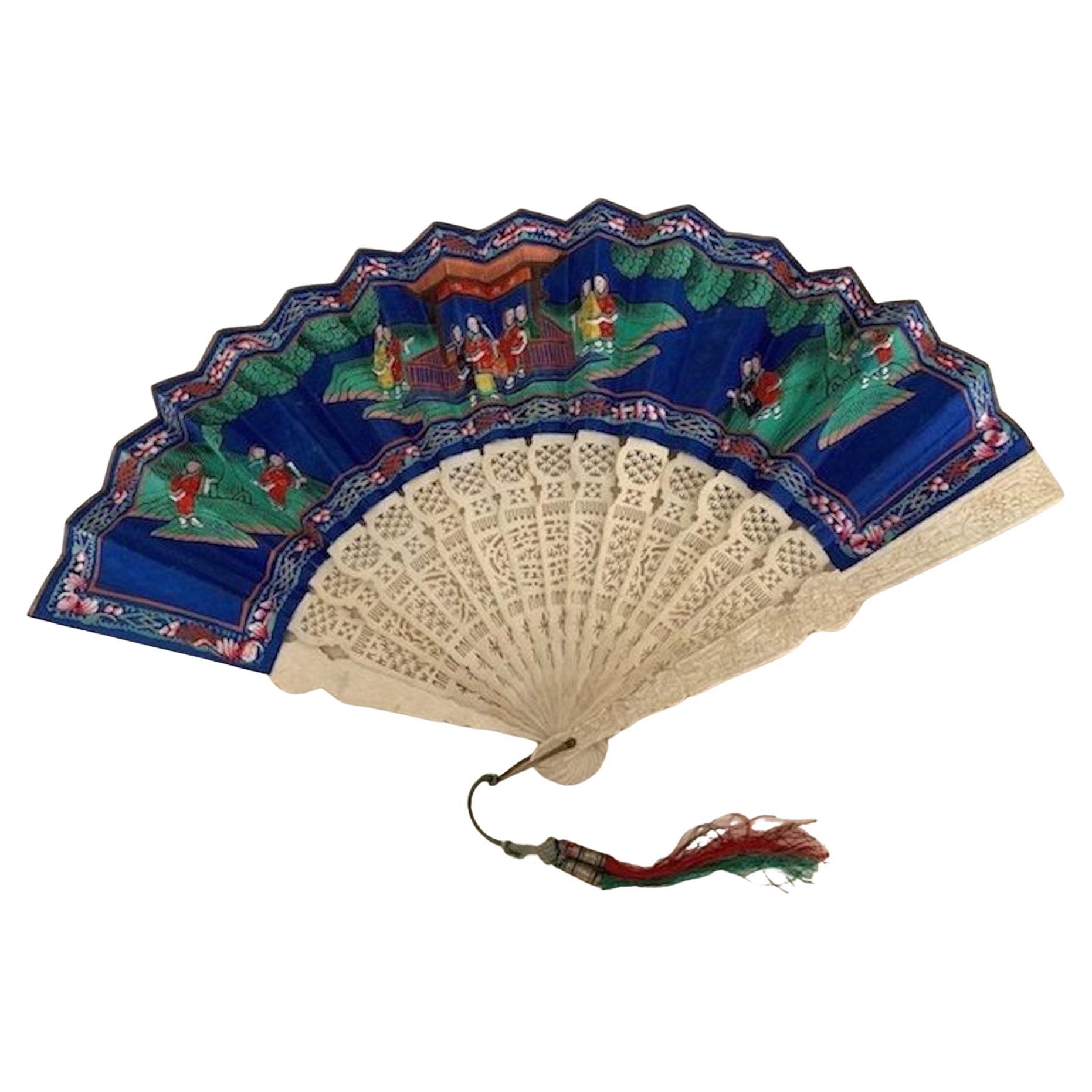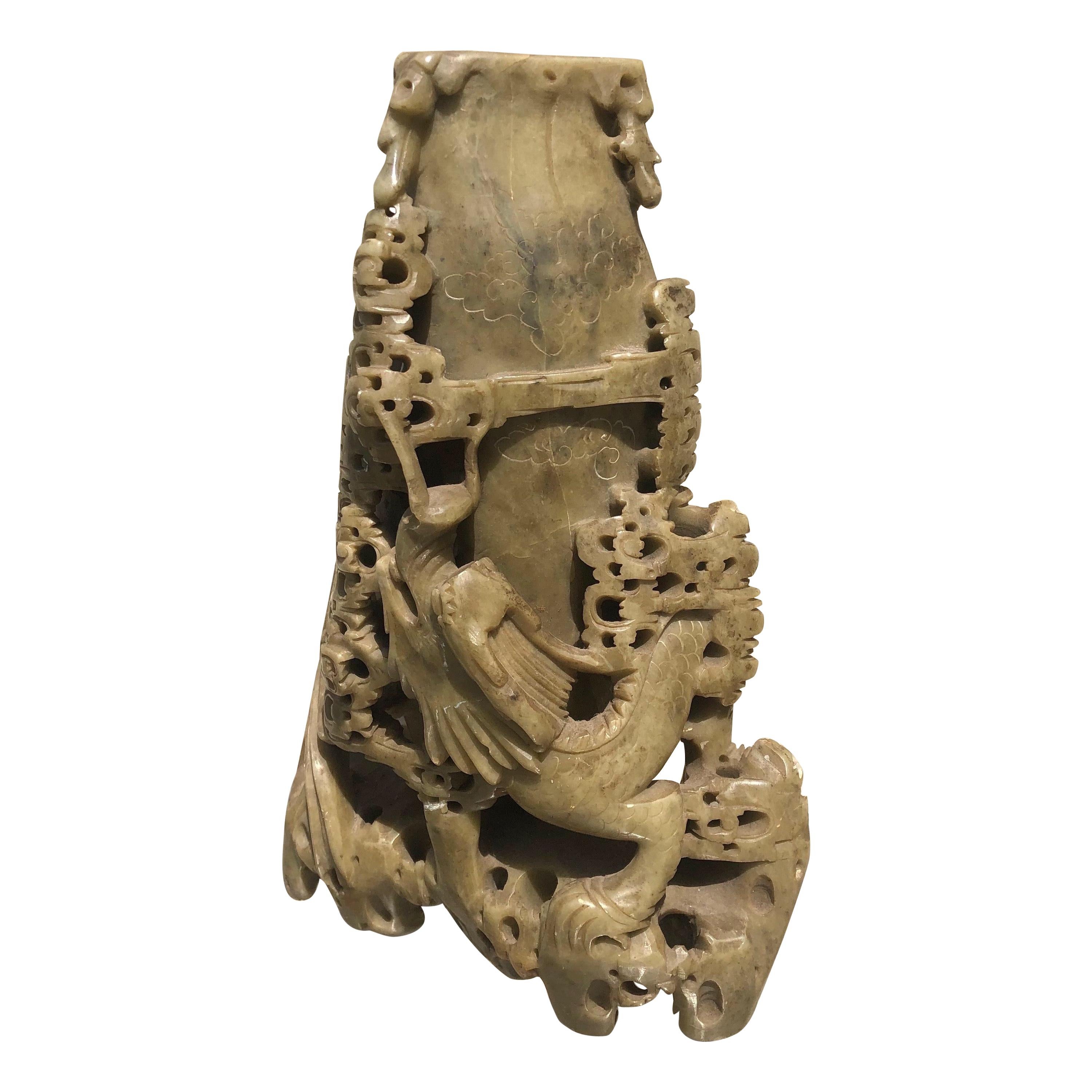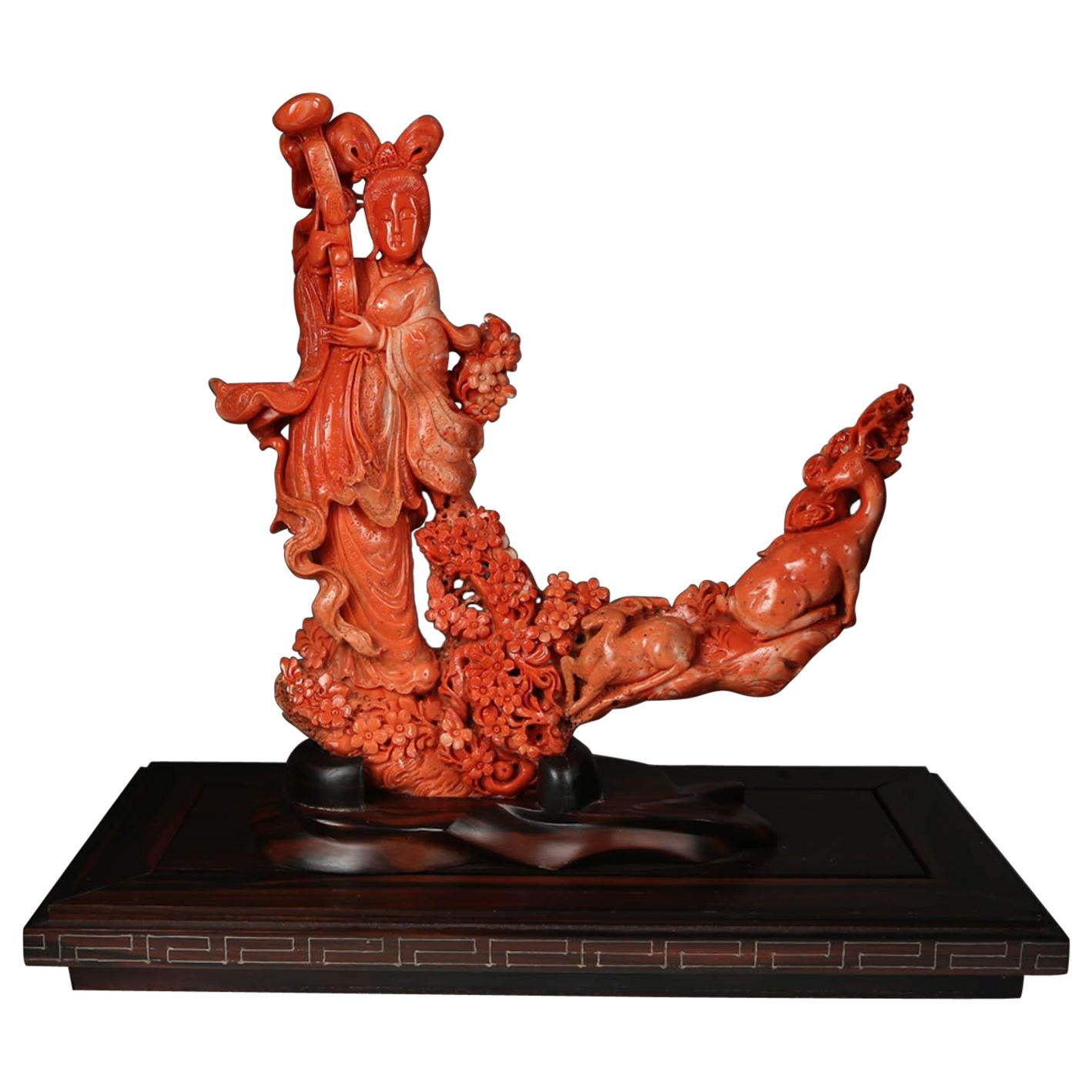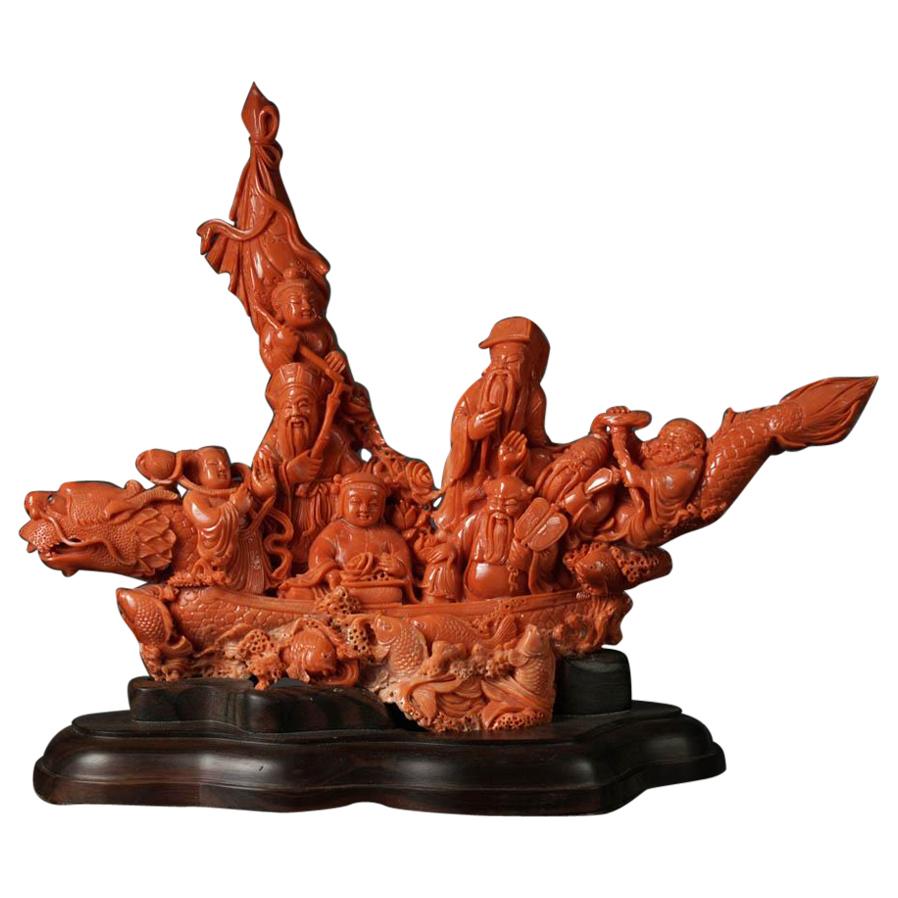Items Similar to Chinese Yellow Vase with High Relief Motif of Bats and Peaches
Want more images or videos?
Request additional images or videos from the seller
1 of 12
Chinese Yellow Vase with High Relief Motif of Bats and Peaches
About the Item
Chinese yellow glass moon flask shaped vase with high relief motif of bats and peaches on a cracquelure design background. The piece dates from the 19th century and has an apocryphal Qianlong mark underneath. In good antique condition.
- Dimensions:Height: 7.75 in (19.69 cm)Width: 6 in (15.24 cm)Depth: 3 in (7.62 cm)
- Style:Chinese Export (Of the Period)
- Materials and Techniques:
- Place of Origin:
- Period:1900-1909
- Date of Manufacture:circa 1900s
- Condition:Wear consistent with age and use.
- Seller Location:New York, NY
- Reference Number:
About the Seller
4.9
Vetted Seller
These experienced sellers undergo a comprehensive evaluation by our team of in-house experts.
1stDibs seller since 2010
2,433 sales on 1stDibs
Typical response time: 2 hours
- ShippingRetrieving quote...Ships From: New York, NY
- Return PolicyThis item cannot be returned.
More From This SellerView All
- Japanese Edo Period Carved Wood Mask of Man with Golden BeardLocated in New York, NYJapanese Edo period carved wood mask of a man with a golden hair beard. The piece shows a very expressive face and was likely made during the 19...Category
Antique 19th Century Japanese Edo Sculptures and Carvings
MaterialsWood
- Japanese Mask of Ko-OmoteLocated in New York, NYA Japanese Noh theatre sculpted wood mask of Ko-Omote, a young girl. The mask was crafted in the early 20th century and is in great vintage condition.Category
Early 20th Century Showa Sculptures and Carvings
MaterialsWood
- Japanese Edo Carved Wood Fox Mask with Articulated JawLocated in New York, NYJapanese Edo period carved wood theatrical animal mask of a fox, with articulated jaw. The piece has a detailed expressive face and was carved d...Category
Antique 18th Century Japanese Edo Sculptures and Carvings
MaterialsWood
- Japanese Meiji Noh Mask of OkinaLocated in New York, NYJapanese carved wood Noh mask depicting Okina. The piece was made during the late Edo - early Meiji period in the 19th century. The mask is of an older man wi...Category
Antique 19th Century Japanese Meiji Sculptures and Carvings
MaterialsWood
- Chinese Enamel Cloisonné Charger with Multicolored Floral MotifLocated in New York, NYChinese metal cloisonné charger with multicolored floral motif on the front face and a blue enamel back with stylized floral motif. The piece was mad...Category
Vintage 1930s Chinese Chinese Export Ceramics
MaterialsMetal
- Japanese Edo Period Kyogen Mask of a Nio GuardianLocated in New York, NYAn extremely rare Japanese Edo period Kyogen mask of a Nio guardian king, a ferocious native deity often associated with the Naga Dragon Kings, who convert...Category
Antique 19th Century Japanese Edo Sculptures and Carvings
MaterialsWood
You May Also Like
- Chinese Jade Statue of a Confucian SageLocated in Milano, ITSplendid statue made of jade in the typically Chinese 19th century. The statue is very beautiful and rests on an oval base made of very fine dark wood. The lower part of the statue ...Category
Antique Early 1800s Chinese Chinese Export Sculptures and Carvings
MaterialsJade
- Beautiful Chinese fan of Canton of the 19th CenturyLocated in Saint-Ouen, FRBeautiful Chinese fan of Canton of the 19th century in Bone, Paper and Silk. Dimensions: H: 49cm, W: 28cm, D: 2cm.Category
Antique 19th Century Chinese Chinese Export Sculptures and Carvings
MaterialsBone, Silk
- Late 19th-Early 20th Century Chinese Carved Soapstone Vase with DragonsLocated in Charleston, SCLate 19th-early 20th century Chinese carved soapstone vase with dragons.Category
Early 20th Century Chinese Sculptures and Carvings
MaterialsSoapstone
- Exceptional Chinese Carved Coral Figure of a Guanyin with DeerLocated in New York, NYAn exceptional Chinese carved coral figure of a Guanyin with deer. Very finely carved. With original wooden base. Measures: Coral: 12" high x...Category
20th Century Chinese Sculptures and Carvings
MaterialsCoral
- A pair of 19th Century carved Foo temple dogs or Chinese guardian LionsLocated in London, GBChinese guardian lions, or imperial guardian lions, are a traditional Chinese architectural ornament. Typically made of stone, they are also known as stone lions or shishi (石獅; shíshī). They are known in colloquial English as lion dogs or foo dogs / fu dogs. The concept, which originated and became popular in Chinese Buddhism, features a pair of highly stylized lions—often one male with a ball and one female with a cub—which were thought to protect the building from harmful spiritual influences and harmful people that might be a threat. Used in imperial Chinese palaces and tombs, the lions subsequently spread to other parts of Asia including Japan (see komainu), Korea, Philippines, Tibet, Thailand, Myanmar, Vietnam, Sri Lanka, Nepal, Cambodia, Laos, and Malaysia. There has been extensive interaction between Chinese mythology and Confucianism, Taoism, and Buddhism. Elements of pre-Han dynasty mythology such as those in Classic of Mountains and Seas were adapted into these belief systems as they developed (in the case of Taoism), or were assimilated into Chinese culture (in the case of Buddhism). Elements from the teachings and beliefs of these systems became incorporated into Chinese mythology. For example, the Taoist belief of a spiritual Paradise became incorporated into mythology as the place where immortals and deities used to dwell. Sometimes mythological and religious ideas have become widespread across China's many regions and diverse ethnic societies. In other cases, beliefs are more limited to certain social groups, for example, the veneration of white stones by the Qiang. One mythological theme that has a long history and many variations involves a shamanic world view, for example in the cases of Mongolian shamanism among the Mongols, Hmong shamanism among the Miao people, and the shamanic beliefs of the Qing dynasty from 1643 to 1912, derived from the Manchus. Politically, mythology was often used to legitimize the dynasties of China, with the founding house of a dynasty claiming a divine descent. Mythology and philosophy. Further information: Chinese philosophy True mythology is distinguished from philosophical treatises and theories. Elaborations on the Wu Xing are not really part of mythology, although belief in five elements could appear. The Hundred Schools of Thought is a phrase suggesting the diversity of philosophical thought that developed during the Warring States of China. Then, and subsequently, philosophical movements had a complicated relationship with mythology. However, as far as they influence or are influenced by mythology, divides the philosophical camps into two rough halves, a Liberal group and a Conservative group. The liberal group being associated with the idea of individuality and change, for example as seen in the mythology of divination in China, such as the mythology of the dragon horse that delivered the eight bagua diagrams to Fu Xi, and methods of individual empowerment as seen in the Yi Jing (Book of Changes). The Liberal tendency is towards individual freedom, Daoism, and Nature. The relationship of the Conservative philosophies to mythology is seen in the legendary Nine Tripod Cauldrons, mythology about the emperors and central bureaucratic governance, Confucianism, written histories, ceremonial observances, subordination of the individual to the social groups of family and state, and a fixation on stability and enduring institutions. The distinction between the Liberal and Conservative is very general, but important in Chinese thought. Contradictions can be found in the details, however these are often traditional, such as the embrace by Confucius of the philosophical aspects of the Yi Jing, and the back-and-forth about the Mandate of Heaven wherein one dynasty ends and another begins based according to accounts (some of heavily mythological) where the Way of Heaven results in change, but then a new ethical stable dynasty becomes established. Examples of this include the stories of Yi Yin, Tang of Shang and Jie of Xia or the similar fantastic stories around Duke of Zhou and King Zhou of Shang. Mythology exists in relationship with other aspects of society and culture, such as ritual. Various rituals are explained by mythology. For example, the ritual burning of mortuary banknotes (Hell Money), lighting fireworks, and so on. A good example of the relationship of Chinese mythology and ritual is the Yubu, also known as the Steps or Paces of Yu. During the course of his activities in controlling the Great Flood, Yu was supposed to have so fatigued himself that he lost all the hair from his legs and developed a serious limp. Daoist practitioners sometimes incorporate a curiously choreographed pedal locomotion into various rituals. Mythology and practice, one explains the other: in these rituals, the sacred time of Yu merges with the sacral practice of the present. Various ideas about the nature of the earth, the universe, and their relationship to each other have historically existed as either a background or a focus of mythologies. One typical view is of a square earth separated from a round sky by sky pillars (mountains, trees, or undefined). Above the sky is the realm of Heaven, often viewed of as a vast area, with many inhabitants. Often the heavenly inhabitants are thought to be of an "as above so below" nature, their lives and social arrangements being parallel to those on earth, with a hierarchical government run by a supreme emperor, many palaces and lesser dwellings, a vast bureaucracy of many functions, clerks, guards, and servants. Below was a vast under ground land, also known as Diyu, Yellow Springs, Hell, and other terms. As time progressed, the idea of an underground land in which the souls of the departed were punished for their misdeeds during life became explicit, related to developments in Daoism and Buddhism. The underground world also came to be conceived of as inhabited by a vast bureaucracy, with kings, judges, torturers, conductors of souls, minor bureaucrats, recording secretaries, similar to the structure of society in the Middle Kingdom (earthly China). Chinese temple Dogs...Category
Antique 1860s Chinese Chinese Export Sculptures and Carvings
MaterialsHardwood
- Exceptional Chinese Carved Coral Figural Group of a Boat with Eight ImmortalsLocated in New York, NYAn exceptional Chinese carved coral figural group or statue of a boat with eight immortals. The boat in a form of a carved dragon wi...Category
Early 20th Century Chinese Sculptures and Carvings
MaterialsCoral
Recently Viewed
View AllMore Ways To Browse
Chinese Yellow
High Relief
Yellow Vase
Yellow Vases
Antique Yellow Glass
Yellow Antique Glass
Yellow Glass Antique
Antique Yellow Vase
Antique Yellow Vases
Relief Carving
Chinese Relief
Antique Peach
High Relief Sculpture
High Relief Carving
China Yellow Vase
Relief Glass Sculptures
Chinese Yellow Glass
High The Moon





